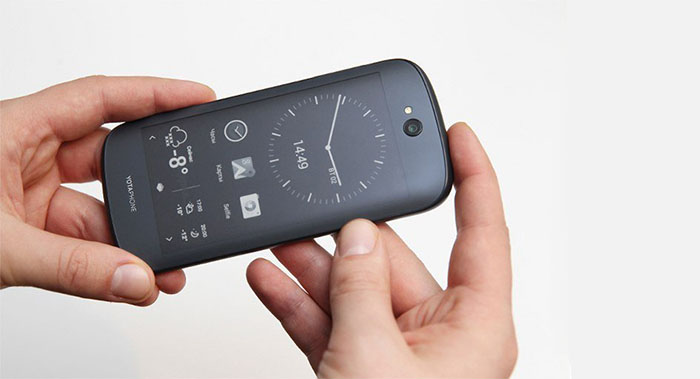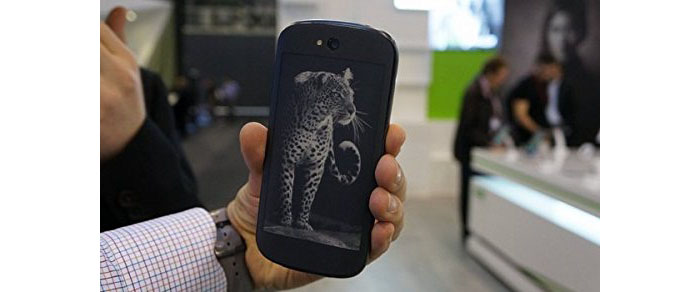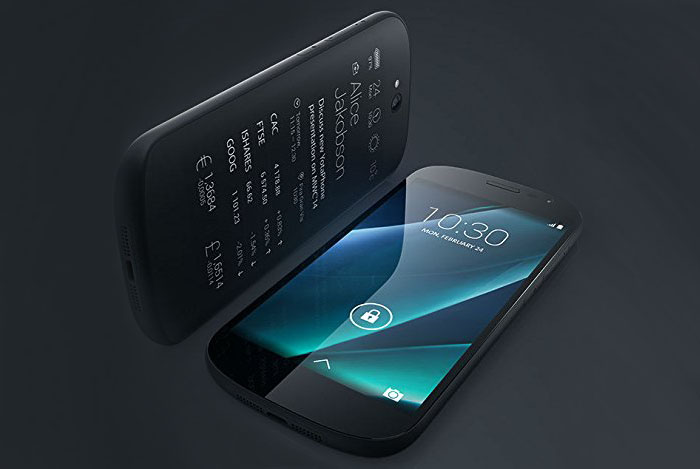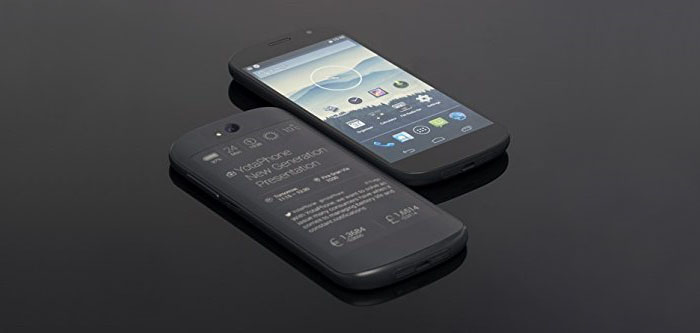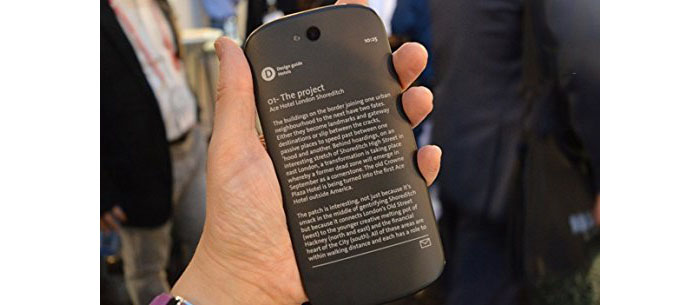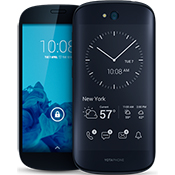When the first YotaPhone appeared, it was greeted with a bit of scepticism and a lot of wonder. We were looking at a fortunate unification between a smartphone and an e-reader device.
But the YotaPhone was more a proof of concept, a prototype, than a finished product. The Russian company tries to refine and enhance what made the YotaPhone unique into the Android world and combine it with new features, resulting into a better, still curious phone, the YotaPhone 2.
But why would you ever need the two of the screens in the same device? It really saves a lot of battery if used correctly. You can use the secondary E-ink screen to read articles, while browsing or even use it as your primary screen.
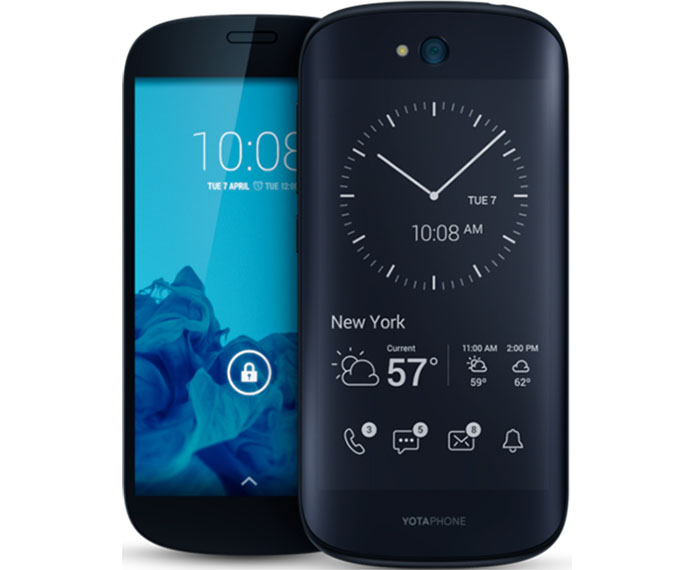
Design
Looking at the front of the YotaPhone 2 you can see the typical Android phone design that we are so accustomed with.
Featuring a plastic frame, with soft, rounded edges, and black matte finish, the YotaPhone 2 has a clean, simple design with a pleasing overall look.
But this is not all, there is Gorilla Glass 3 on front and back, making the phone feel solid and because there is a second display, the phone is a bit thicker than most flagship phones on the market, measuring 5.70×2.73×0.35in and weighing 5.11 oz.
On the right side you can find the power/lock and volume controller, which doubles as the nanoSIM tray; at the base rests the speaker and the microUSB port and lastly, at the top, you can find the 3.5mm headphone jack.
The back panel is home to the 4.7 inch Eink display that curves at the left and right edges. The screen is readable, without glare.
A problem that we encountered with the design is that holding the phone with the main screen is comfortable and has a good grip, but turn the screen around and the edges are now sharp and the grip is not as comfortable as with the other display.
Overall, the YotaPhone 2 is very polished, the design is quite unique (though didn’t feel as premium material) and as expected, the main attraction is the E-ink display.
Display
YotaPhone 2 has a 5-inch AMOLED display with a resolution of 1920x1080p and pixel density of 442ppi. The AMOLED panels are known for their deep blacks, vibrant colours and large viewing angles and the YotaPhone 2 takes full advantage of these features.
But at the same time we noticed that the phone tends to oversaturate the images and the colour accuracy is slightly off. In terms of brightness, the display can be viewed under normal light but doesn’t fare too well under intense sunlight, like on the beach.
Overall, the main display is reasonable, movies look good and games are rendered with enough details, but considering the price tag we expected quality similar to what other flagships have to offer (like LG G4).
Now, for the 4.7-inch E-ink display. The resolution is 960×540 (yes…the resolution is low, but you will watch movies on the other side), it is capable of producing 16 different shades of grey and the screen is full-touch (unlike the previous model).
So, considering these facts, this display is best when using for reading (although there is a bit of pixelation) or web browsing. A major complaint about the E-ink display is that it has a lot of ghosting, parts of previous pages can still be visible even after new pages have been loaded.
Performance
YotaPhone 2 sports a 2.3GHz Quad-core Qualcomm Snapdragon 801 chipset backed by an Adreno 330 GPU, 2GB RAM and 32GB internal memory. Unfortunately, there is no microSD slot available.
Overall, the performance is decent, applications loaded quickly, video streaming is reasonably smooth and we were able to play games at maximum graphics settings without lags or stuttering (Asphalt 8: Airborne played smoothly).
Performance on the E-ink display is quite different. Thanks to the Yota Mirror, you can basically mirror what you were doing on the AMOLED screen onto the E-ink display. Although this is a fun feature, trying to view or run applications with high refresh rate actually drains the battery faster and the screen gets extremely laggy.
So, as said before, the E-ink display doesn’t work best with dynamic apps, preferring the static ones.
From the connectivity point of view, the YotaPhone 2 supports 802/11 ac/a/b/g/n, GPS/GLONASS, Bluetooth 4 and 4 LTE.
Software
The YotaPhone 2 runs an almost stock Android 4.4.3 KitKat, the YETI 2.0 UI (you can upgrade to Lollipop as it will improve the battery life). It only has included some YotaPhone apps, like YotaHub, YotaNotes, YotaMessage or YotaFit. Another addition, thanks to Yota 2 is that it now features custom interface skins.
The E-ink display is very customizable. Using the YotaCover you can display every type of notification (text messages, emails, calls), change the background image or cycle some images every few minutes.
Besides the YotaCover, you can use the YotaPanel that acts as your home screen. Basically you can customize and fill the home screen with a large array of widgets or apps shortcuts.
Because the E-ink display is always on, you can immediately see new notifications and even if the phone’s battery is empty, you can select an image that will remain on the display (for example, a map).
The YotaPhone 2 does have a learning curve, it will take some time before you will get accustomed to the phones quirks.
Camera
YotaPhone 2 features a 8-megapixel rear camera (capable of shooting 3264x2448p pictures) and a 2.1-megapixel front camera. Considering the price tag, the camera is pretty much average and thanks to the Android Lollipop upgrade, now has more options than what the previous OS offered (yes, the camera application is just the stock Android app).
It does offer HDR, Panorama, Face Detection, Geo-Tagging, Lens Blur and Photo Sphere. The camera works good in bright scenarios, pictures were reasonable, especially if using the HDR to add contrast.
Still, the level of detail is lacking, colours are a bit washed out and you will notice this a lot more when shooting in not-so-ideal conditions (low-lit scenes).
As a conclusion, YotaPhone 2 is able to shoot good pictures if conditions are close to ideal, but since usually, this is not the case, you will be a bit disappointed by the camera, since this performance is expected from a mid-range phone camera.
But we are paying for the dual-screen feature and not the camera after all.
Lastly, the camera can film in 1080p at 30FPS.
Battery Life
YotaPhone 2 has a 2500mAh non-removable battery, capable of delivering a full day if only the AMOLED screen is used. But if you use the E-ink display, the battery life improves by a lot.
The main reason the second display was installed is so that people can get a lot more from the battery. If you distribute the phones’ displays, one for movies and games and the other for any other app, you can get 3 to 4 days of battery life. But if you use only the E-ink display you will get a lot more.
Note: The typical e-readers can go for months before needing recharging.
Conclusion
In an oversaturated market, this Android smartphone comes with something new, unique and considering the fact that the original YotaPhone was not a finished phone, it’s great seeing such improvement from one generation of smartphones to the other.
So, the YotaPhone 2 offers a good AMOLED display, an almost stock version of Android, good connectivity and can shoot reasonable pictures. But what justifies the price tag and sets this smartphone apart from the others is the E-ink display that does a really great job. A lot of other smartphone manufacturers tried this fusion but the YotaPhone 2 seems to be the only one to get it right so far.
Note: The YotaPhone 3 release date is expected in Q1 of 2016.

